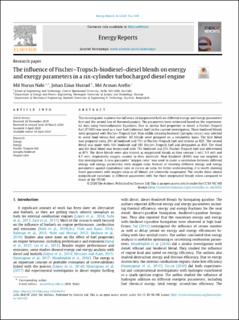| dc.contributor.author | Nabi, Md Nurun | |
| dc.contributor.author | Hustad, Johan Einar | |
| dc.contributor.author | Arefin, Md Arman | |
| dc.date.accessioned | 2022-05-13T12:46:42Z | |
| dc.date.available | 2022-05-13T12:46:42Z | |
| dc.date.created | 2021-01-05T16:05:48Z | |
| dc.date.issued | 2020 | |
| dc.identifier.citation | Energy Reports. 2020, 6 832-840. | en_US |
| dc.identifier.issn | 2352-4847 | |
| dc.identifier.uri | https://hdl.handle.net/11250/2995662 | |
| dc.description.abstract | This investigation explores the influence of oxygenated fuels on different energy and exergy parameters first and the second law of thermodynamics. The parameters were estimated based on the experimental data using thermodynamic Equations. Due to similar fuel properties to diesel, a Fischer–Tropsch fuel (FT100) was used as a base fuel (reference fuel) in the current investigation. Three biodiesel blends were prepared with Fischer–Tropsch fuel. Non-edible Jatropha biodiesel (Jatropha curcas) was selected to avoid food versus fuel conflict. All blends were prepared on a volumetric basis. The first blend was prepared using 25% of biodiesel and 75% of Fischer–Tropsch fuel and termed as B25. The second blend was made with 50% biodiesel and 50% Fischer–Tropsch fuel and designated as B50. The third and the final blend was formulated with 75% biodiesel and 25% Fischer–Tropsch fuel and abbreviated as B75. The three blends were also termed as oxygenated blends as they contain 3 wt%, 5.9 wt% and 8.7 wt%, respectively oxygen content in their molecule. Neat biodiesel (B100) was not targeted in this investigation. A new parameter “oxygen ratio” was used to make a correlation between different energy and exergy parameters with oxygen ratio. Instead of showing different energy and exergy parameters against equivalence ratio or excess air ratio, for better understanding, it is worth showing those parameters with oxygen ratio as all blends are inherently oxygenated. The results show almost insignificant variations in different parameters with the three oxygenated blends when compared to those of the FT100. | en_US |
| dc.language.iso | eng | en_US |
| dc.publisher | Elsevier | en_US |
| dc.rights | Attribution-NonCommercial-NoDerivatives 4.0 Internasjonal | * |
| dc.rights.uri | http://creativecommons.org/licenses/by-nc-nd/4.0/deed.no | * |
| dc.title | The influence of Fischer–Tropsch-biodiesel–diesel blends on energy and exergy parameters in a six-cylinder turbocharged diesel engine | en_US |
| dc.title.alternative | The influence of Fischer–Tropsch-biodiesel–diesel blends on energy and exergy parameters in a six-cylinder turbocharged diesel engine | en_US |
| dc.type | Peer reviewed | en_US |
| dc.type | Journal article | en_US |
| dc.description.version | publishedVersion | en_US |
| dc.source.pagenumber | 832-840 | en_US |
| dc.source.volume | 6 | en_US |
| dc.source.journal | Energy Reports | en_US |
| dc.identifier.doi | 10.1016/j.egyr.2020.04.011 | |
| dc.identifier.cristin | 1865864 | |
| cristin.ispublished | true | |
| cristin.fulltext | original | |
| cristin.qualitycode | 1 | |

